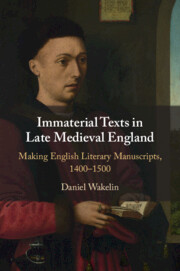Book contents
- Immaterial Texts in Late Medieval England
- Immaterial Texts in Late Medieval England
- Copyright page
- Epigraph
- Contents
- Figures
- Acknowledgements
- Abbreviations, Quotations and References
- Chapter 1 Prologue
- Chapter 2 ‘Hele alle maner of schabbis’
- Chapter 3 ‘Who by prudence Rule him shal’
- Chapter 4 ‘Þe leef torned’
- Chapter 5 ‘Rede … and ʒe may se’
- Chapter 6 ‘This is the copy’
- Chapter 7 Conclusions
- Bibliography
- List of Manuscripts
- General Index
Chapter 2 - ‘Hele alle maner of schabbis’
Imagining Perfect Parchment
Published online by Cambridge University Press: 12 May 2022
- Immaterial Texts in Late Medieval England
- Immaterial Texts in Late Medieval England
- Copyright page
- Epigraph
- Contents
- Figures
- Acknowledgements
- Abbreviations, Quotations and References
- Chapter 1 Prologue
- Chapter 2 ‘Hele alle maner of schabbis’
- Chapter 3 ‘Who by prudence Rule him shal’
- Chapter 4 ‘Þe leef torned’
- Chapter 5 ‘Rede … and ʒe may se’
- Chapter 6 ‘This is the copy’
- Chapter 7 Conclusions
- Bibliography
- List of Manuscripts
- General Index
Summary
Chapter 2 discusses the scribes’ handling of damage and irregularity in parchment in manuscripts of English literature. It sets out how damage and irregularity arose and describes the methods scribes used to repair or counteract those features of parchment. From these methods, the author infers that scribes ignored and even obscured the organic oddity and damage in parchment, instead hylomorphically pursuing an idea of the page more perfect and more rectilinear than was the matter on which they imposed it, and in some cases worried about disruptions to the text’s appearance and reception. Rather than engage with the agency of their materials, they imposed on them immaterial ideas about the book and the use of its texts.
- Type
- Chapter
- Information
- Immaterial Texts in Late Medieval EnglandMaking English Literary Manuscripts, 1400–1500, pp. 23 - 68Publisher: Cambridge University PressPrint publication year: 2022

